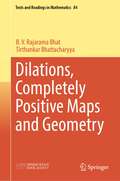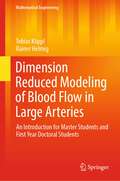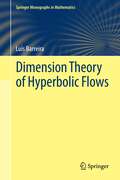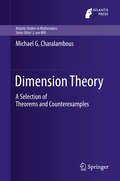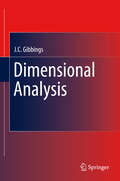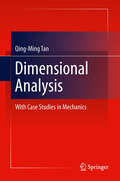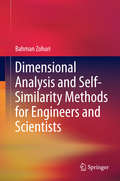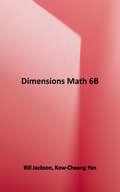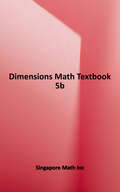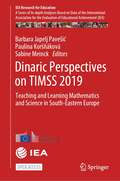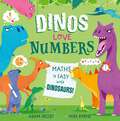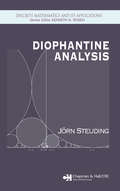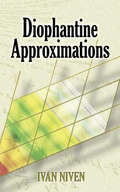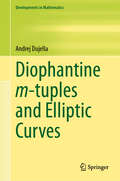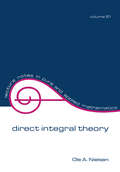- Table View
- List View
Digitalisierung im Mathematikunterricht: Theorie und Praxis digitaler Medien in der Sekundarstufe I (Mathematik Primarstufe und Sekundarstufe I + II)
by Gilbert Greefrath Hans-Stefan Siller Hans-Georg Weigand Reinhard Oldenburg Volker UlmDieses Buch zeigt, wie verschiedene digitale Medien als Lern- und Lehrhilfsmittel in den Mathematikunterricht integriert werden können: Es stellt theoretische Überlegungen und Konzeptionen dar und zeigt an vielen unterrichtspraktischen Beispielen, wie Taschenrechner, Laptop und Smartphone mit der entsprechenden Software und dem Internet im Unterricht eingesetzt werden können. Das dargestellte Programm-Spektrum reicht von Computeralgebrasystemen über dynamische Geometriesysteme, Tabellenkalkulationen und 3D-Druck bis hin zu interaktiven Lernumgebungen, auch mit Virtueller Realität und Augmented Reality. Der Einsatz der Medien orientiert sich dabei stets am zentralen Ziel, die Entwicklung vielfältiger Kompetenzen bei Schülerinnen und Schülern nachhaltig zu unterstützen. Das Buch wendet sich an Studierende des Lehramts Mathematik, an Referendarinnen und Referendare sowie praktizierende Lehrkräfte. Es konzentriert sich auf zentrale Inhalte der Sekundarstufe I – also Zahlen, Algebra, Funktionen, Geometrie sowie Daten und Zufall. Um Leserinnen und Leser zur eigenständigen Auseinandersetzung mit digitalen Medien anzuregen, sind am Ende jedes Kapitels Aufgaben zur individuellen Bearbeitung angefügt. Materialien zu den Inhalten, vor allem interaktive Elemente, sind auf einer eigenen Internetseite zusammengestellt. Das vorliegende Buch ist eine vollständige Neubearbeitung des Buches „Computer im Mathematikunterricht“ von Hans-Georg Weigand und Thomas Weth aus dem Jahr 2002.
Digitalisierung: Wie Die Digitalisierung Unsere Lebens- Und Arbeitswelt Verändert
by Dietmar Wolff Richard GöbelDieses Buch befasst sich mit der digitalen Revolution und ihren Auswirkungen auf unsere Arbeits- und Lebenswelt. Die Autoren zeigen anhand anschaulicher Beispiele auf, wie die Digitalisierung unsere Arbeitsplätze und unser privates Umfeld verändert, welche Gefahren damit verbunden sind, aber auch welche Zukunftschancen darin liegen.Dieses Buch wird Sie interessieren, wenn Sie die Gefahren und Potenziale von Big Data und modernem Marketing sowie die notwendigen Hintergründe zur IT-Sicherheit und zum Datenschutz kennen möchten, an „4.0“ in Mittelstand und Industrie interessiert sind und zu den Visionen eines zukünftigen Gesundheits- und Bildungswesens mitgenommen werden wollen.Dabei sind keine fachlichen Vorkenntnisse in Informationstechnologie oder verwandten Gebieten erforderlich. Der Inhalt ist für ein fachfremdes, allgemeines Publikum geschrieben, das die technologischen Hintergründe der Digitalisierung verstehen möchte, um die Veränderungen im eigenen Umfeld verstehen und einordnen zu können. Mehr noch, da die Digitalisierung keinen Halt vor einer Berufsgruppe oder einem privaten Bereich macht, ist das Werk letztendlich für alle von Bedeutung.
Digitalization and Innovation in Health: European and US Perspectives
by Weresa Anna Marzenna Christina Ciecierski Lidia FilusProviding a comparison between context in Europe and the US, this volume investigates the digital transformation of health systems, comparing strategies for digital development while identifying both key innovations and future challenges.The book covers a wide spectrum of topics, from explaining the nature of individual innovations to an analysis of demand-side and supply-side barriers, including funding issues and technological access. It also explores where digitalization is already playing an important role, for example, in clinical trials and disease modeling.Concluding with guidance for policy recommendations, this important book will interest students, scholars, and practitioners across health and social care, medicine, and beyond.
Digits Enhanced Student Companion (Grade #7)
by Prentice HallA guide book to mastering mathematical skills and concepts that relevant to you; as it provides a place to demonstrate your understanding of lesson skills and concepts in writing.
Digressions in Elementary Probability: The Unexpected in Medicine, Sports, and Society (Quantitative Methods in the Humanities and Social Sciences)
by Edward BeltramiThis book is about the interplay between chance and order, but limited to mostly binary events, such as success/failure as they occur in a diversity of interesting applications. The goal is to entertain and instruct with topics that range from unexpected encounters with chance in everyday experiences, to significant “must know” insights regarding human health and other concerns in the social sciences. The first section provides the tools for being able to discuss random sequences with hints at what is to follow. This is followed by another surprising and, to some extent, bizarre result known as Stein’s Paradox, which is applied to baseball. The troublesome topic of disease clusters, namely to decide whether the clumping of events is due to chance or some environmental cause, is treated using both the Poisson and normal approximations to the binomial distribution and this leads naturally into a discussion of the base rate fallacy and a case study of hospital performance. Next, another medical case study this time concerning some tricky questions about the effectiveness of colonoscopy and other medical interventions. A brief discussion of the mathematics of clinical trials, follows. Then, the book examines the error in random sampling, when polling for candidate preference with specific current examples. The essential tool here is covariance of random variables. The author follows this with a treatment of the spooky quality of coincidence using appropriate mathematical tools. After this, code breaking at Bletchley Park using Baye’s theorem. It returns to Poisson events to discuss another unexpected result, followed by the use of spatial Poisson events in the delivery of emergency response services. Finally, an account of fluctuations that occur in a run of Bernoulli trials as a bookend to the very first section of the book. The probability theory involved is elementary using the binomial theorem and its extensions to Poisson and normal events in addition to conditional probability and covariance. The author provides an optional brief tutorial at the end, that covers the basic ideas in probability and statistics needed in the main text. Besides a list of references, several codes written in Matlab that were used to illustrate various topics in the text, as well as to support several figures that appear throughout, are provided.
Dilations, Completely Positive Maps and Geometry (Texts and Readings in Mathematics #84)
by Tirthankar Bhattacharyya B.V. Rajarama BhatThis book introduces the dilation theory of operators on Hilbert spaces and its relationship to complex geometry. Classical as well as very modern topics are covered in the book. On the one hand, it introduces the reader to the characteristic function, a classical object used by Sz.-Nagy and Foias and still a topic of current research. On the other hand, it describes the dilation theory of the symmetrized bidisc which has been developed mostly in the present century and is a very active topic of research. It also describes an abstract theory of dilation in the setting of set theory. This was developed very recently.A good portion of the book discusses various geometrical objects like the bidisc, the Euclidean unit ball, and the symmetrized bidisc. It shows the similarities and differences between the dilation theory in these domains. While completely positive maps play a big role in the dilation theory of the Euclidean unit ball, this is not so in the symmetrized bidisc for example. There, the central role is played by an operator equation. Targeted to graduate students and researchers, the book introduces the reader to different techniques applicable in different domains.
Dimension Reduced Modeling of Blood Flow in Large Arteries: An Introduction for Master Students and First Year Doctoral Students (Mathematical Engineering)
by Rainer Helmig Tobias KöpplThis monograph contains an in-depth and coherent treatment of dimension-reduced modeling of blood flows on the level of large vessels (macrocirculation). The authors reduce the complexity by combining a one-dimensional Navier-Stokes equation and a simplified FSI-concept. The influence of omitted vessels, which are subsequent to the outlets of larger vessels, is accounted for by systems of ordinary differential equations (0D models). The target audience primarily comprises research experts in the field of biomedical engineering, but the book may also be beneficial for graduate students alike.
Dimension Theory of Hyperbolic Flows
by Luís BarreiraThe dimension theory of dynamical systems has progressively developed, especially over the last two decades, into an independent and extremely active field of research. Its main aim is to study the complexity of sets and measures that are invariant under the dynamics. In particular, it is essential to characterizing chaotic strange attractors. To date, some parts of the theory have either only been outlined, because they can be reduced to the case of maps, or are too technical for a wider audience. In this respect, the present monograph is intended to provide a comprehensive guide. Moreover, the text is self-contained and with the exception of some basic results in Chapters 3 and 4, all the results in the book include detailed proofs. The book is intended for researchers and graduate students specializing in dynamical systems who wish to have a sufficiently comprehensive view of the theory together with a working knowledge of its main techniques. The discussion of some open problems is also included in the hope that it may lead to further developments. Ideally, readers should have some familiarity with the basic notions and results of ergodic theory and hyperbolic dynamics at the level of an introductory course in the area, though the initial chapters also review all the necessary material.
Dimension Theory: A Selection of Theorems and Counterexamples (Atlantis Studies in Mathematics #7)
by Michael G. CharalambousThis book covers the fundamental results of the dimension theory of metrizable spaces, especially in the separable case. Its distinctive feature is the emphasis on the negative results for more general spaces, presenting a readable account of numerous counterexamples to well-known conjectures that have not been discussed in existing books. Moreover, it includes three new general methods for constructing spaces: Mrowka's psi-spaces, van Douwen's technique of assigning limit points to carefully selected sequences, and Fedorchuk's method of resolutions. Accessible to readers familiar with the standard facts of general topology, the book is written in a reader-friendly style suitable for self-study. It contains enough material for one or more graduate courses in dimension theory and/or general topology. More than half of the contents do not appear in existing books, making it also a good reference for libraries and researchers.
Dimensional Analysis
by J. C. GibbingsFor experiments, dimensional analysis enables the design, checks the validity, orders the procedure and synthesises the data. Additionally it can provide relationships between variables where standard analysis is not available. This widely valuable analysis for engineers and scientists is here presented to the student, the teacher and the researcher. It is the first complete modern text that covers developments over the last three decades while closing all outstanding logical gaps. Dimensional Analysis also lists the logical stages of the analysis, so showing clearly the care to be taken in its use while revealing the very few limitations of application. As the conclusion of that logic, it gives the author's original proof of the fundamental and only theorem. Unlike past texts, Dimensional Analysis includes examples for which the answer does not already exist from standard analysis. It also corrects the many errors present in the existing literature by including accurate solutions. Dimensional Analysis is written for all branches of engineering and science as a teaching book covering both undergraduate and postgraduate courses, as a guide for the lecturer and as a reference volume for the researcher.
Dimensional Analysis
by Qing-Ming TanDimensional analysis is an essential scientific method and a powerful tool for solving problems in physics and engineering. This book starts by introducing the Pi Theorem, which is the theoretical foundation of dimensional analysis. It also provides ample and detailed examples of how dimensional analysis is applied to solving problems in various branches of mechanics. The book covers the extensive findings on explosion mechanics and impact dynamics contributed by the author's research group over the past forty years at the Chinese Academy of Sciences. The book is intended for research scientists and engineers working in the fields of physics and engineering, as well as graduate students and advanced undergraduates of the related fields. Qing-Ming Tan is a former Professor at the Institute of Mechanics, the Chinese Academy of Sciences, China.
Dimensional Analysis and Self-Similarity Methods for Engineers and Scientists
by Bahman ZohuriThis ground-breaking reference provides an overview of key concepts in dimensional analysis, and then pushes well beyond traditional applications in fluid mechanics to demonstrate how powerful this tool can be in solving complex problems across many diverse fields. Of particular interest is the book's coverage of dimensional analysis and self-similarity methods in nuclear and energy engineering. Numerous practical examples of dimensional problems are presented throughout, allowing readers to link the book's theoretical explanations and step-by-step mathematical solutions to practical implementations.
Dimensions Math 6B
by Bill Jackson Kow Cheong YanDimensions Math is a series designed to teach middle school students foundational skills in mathematics. It follows the Singapore Mathematics Framework and covers the content standards in the United States Common Core State Standards for mathematics. This series empowers students to solve problems and master concepts through the thoughtful use of different approaches. It facilitates students’ understanding and internalization of concepts and encourages deep exploration of topics. Students will enjoy learning math through this comprehensive system and be motivated to study, discover, and apply knowledge in real-life situations.
Dimensions Math Textbook 5B
by Singapore Math Inc Various RolesThe Dimensions Math® Pre-Kindergarten to Grade 5 series is based on the pedagogy and methodology of math education in Singapore. The curriculum develops concepts in increasing levels of abstraction, emphasizing the three pedagogical stages: Concrete, Pictorial, and Abstract. Each topic is introduced, then thoughtfully developed through the use of problem solving, student discourse, and opportunities for mastery of skills.
Dimensionstheorie (essentials)
by Jörg NeunhäusererDieses Essential gibt eine kompakte Einführung in die Dimensionstheorie. Die topologische Dimension und mehrere fraktale Dimensionen werden definiert und anhand von Beispielen erläutert. Lesende lernen grundlegende Sätze über die Dimension von kartesischen Produkten, Projektionen, Schnitten und arithmetischen Summen kennen. Weiterhin wird eine Vielfalt von Anwendungen der Dimensionstheorie in der Zahlentheorie, der Geometrie, der Analysis, den dynamischen Systemen und der Stochastik vorgestellt.
Dinaric Perspectives on TIMSS 2019: Teaching and Learning Mathematics and Science in South-Eastern Europe (IEA Research for Education #13)
by Barbara Japelj Pavešić Paulína Koršňáková Sabine MeinckThis open access book brings together national experts from across the Dinaric region to rigorously review IEA’s Trends in International Mathematics and Science Study (TIMSS) 2019 grade four data to develop a multidimensional and culturally sensitive perspective on their TIMSS 2019 primary-level results. The Dinaric region, named after the Dinaric Alps, is located in South-eastern Europe, and stretches through Croatia, Bosnia and Herzegovina, Serbia, Montenegro, Kosovo[1], Albania, and North Macedonia. IEA’s TIMSS has been an invaluable resource for monitoring international trends in mathematics and science achievement at grades four and eight since 1995. The TIMSS 2019 administration of the test to grade four students, provided a unique opportunity for analysis within shared regional settings and enabled the construction of this first report based on international study results from the region, prepared by the National Research Coordinators in collaboration with IEA. [1] This designation is without prejudice to positions on status and is in line with UNSCR 1244/1999 and the ICJ Opinion on the Kosovo declaration of independence.
Dingers: The 101 Most Memorable Home Runs in Baseball History
by Joshua Shifrin Tommy SheaFrom splitters to spitters; from a frozen rope to the suicide squeeze; from extra innings to no hitters, baseball is truly a great game. But nothing hypes up a crowd like a home run, a round tripper, a big bomb . . . the long ball! Hitting the ball out of the park is one of the greatest feats in baseball, and doing so in the clutch can make an average player a hero overnight.In Dingers, authors Joshua Shifrin and Tom Shea break down the 101 most memorable home runs in baseball history, telling their stories and how they affected the game of baseball. Whether it’s "The Shot Heard ’Round the World” or Hank Aaron’s 715th blast, readers will get an inside scoop on some of the most famous moments that now live in baseball lore.Whether you were there when Reggie Jackson hit three-straight home runs in Game 6 of the 1977 World Series, watched Joe Carter’s 1993 World Series-winning home run live, or have seen highlights from Bill Mazeroski’s memorable shot in Game 7 of the 1960 World Series, Dingers is for baseball fans young and old. Relive the moments you cherish to the ones you’ve only heard tales about.Skyhorse Publishing, as well as our Sports Publishing imprint, are proud to publish a broad range of books for readers interested in sports-books about baseball, pro football, college football, pro and college basketball, hockey, or soccer, we have a book about your sport or your team.Whether you are a New York Yankees fan or hail from Red Sox nation; whether you are a die-hard Green Bay Packers or Dallas Cowboys fan; whether you root for the Kentucky Wildcats, Louisville Cardinals, UCLA Bruins, or Kansas Jayhawks; whether you route for the Boston Bruins, Toronto Maple Leafs, Montreal Canadiens, or Los Angeles Kings; we have a book for you. While not every title we publish becomes a New York Times bestseller or a national bestseller, we are committed to publishing books on subjects that are sometimes overlooked by other publishers and to authors whose work might not otherwise find a home.
Dinos Love Numbers: Maths is easy with dinosaurs!
by Adam FrostIntroduce young readers to the magical world of numbers with this fun, dinosaur-themed picture book!Packed with amazing dinosaur facts and awe-inspiring numbers, Dinos Love Numbers looks at shapes, fractions, addition, subtraction, measurements and so much more. Wherever you go you will bump noses with numbers, rub shoulders with shapes or have a chance meeting with multiplication, and guess what: numbers are SUPER fun. Don't believe me? Try this for dinosaur-loving-size...Which dino was as heavy as 10 elephants? (It's the Alamosaurus, of course!)Who would win in a dino race? (A Velociraptor. Speedy!)Which dinosaur is THREE TIMES the length of a great white shark? (A Megalodon. It was ENORMOUS!)The perfect picture book for all maths-loving kids, dinosaur-loving kids and those kids who are not sure about numbers, Dinos Love Numbers has fun illustrations and is packed with super-cool prehistoric creatures to make maths fun for children aged 5+.
Diophantine Analysis
by Jorn SteudingWhile its roots reach back to the third century, diophantine analysis continues to be an extremely active and powerful area of number theory. Many diophantine problems have simple formulations, they can be extremely difficult to attack, and many open problems and conjectures remain. Diophantine Analysis examines the theory of diophantine ap
Diophantine Analysis
by Jörn SteudingThis collection of course notes from a number theory summer school focus on aspects of Diophantine Analysis, addressed to Master and doctoral students as well as everyone who wants to learn the subject. The topics range from Baker's method of bounding linear forms in logarithms (authored by Sanda Bujačić and Alan Filipin), metric diophantine approximation discussing in particular the yet unsolved Littlewood conjecture (by Simon Kristensen), Minkowski's geometry of numbers and modern variations by Bombieri and Schmidt (Tapani Matala-aho), and a historical account of related number theory(ists) at the turn of the 19th Century (Nicola M. R. Oswald). Each of these notes serves as an essentially self-contained introduction to the topic. The reader gets a thorough impression of Diophantine Analysis by its central results, relevant applications and open problems. The notes are complemented with many references and an extensive register which makes it easy to navigate through the book.
Diophantine Approximation and Dirichlet Series (Texts and Readings in Mathematics #80)
by Hervé Queffelec Martine QueffelecThe second edition of the book includes a new chapter on the study of composition operators on the Hardy space and their complete characterization by Gordon and Hedenmalm. The book is devoted to Diophantine approximation, the analytic theory of Dirichlet series and their composition operators, and connections between these two domains which often occur through the Kronecker approximation theorem and the Bohr lift. The book initially discusses Harmonic analysis, including a sharp form of the uncertainty principle, Ergodic theory and Diophantine approximation, basics on continued fractions expansions, and the mixing property of the Gauss map and goes on to present the general theory of Dirichlet series with classes of examples connected to continued fractions, Bohr lift, sharp forms of the Bohnenblust–Hille theorem, Hardy–Dirichlet spaces, composition operators of the Hardy–Dirichlet space, and much more. Proofs throughout the book mix Hilbertian geometry, complex and harmonic analysis, number theory, and ergodic theory, featuring the richness of analytic theory of Dirichlet series. This self-contained book benefits beginners as well as researchers.
Diophantine Approximations (Dover Books on Mathematics)
by Ivan NivenThis self-contained treatment originated as a series of lectures delivered to the Mathematical Association of America. It covers basic results on homogeneous approximation of real numbers; the analogue for complex numbers; basic results for nonhomogeneous approximation in the real case; the analogue for complex numbers; and fundamental properties of the multiples of an irrational number, for both the fractional and integral parts.The author refrains from the use of continuous fractions and includes basic results in the complex case, a feature often neglected in favor of the real number discussion. Each chapter concludes with a bibliographic account of closely related work; these sections also contain the sources from which the proofs are drawn.
Diophantine Equations and Power Integral Bases: Theory and Algorithms
by István GaálWork examines the latest algorithms and tools to solve classical types of diophantine equations.; Unique book---closest competitor, Smart, Cambridge, does not treat index form equations.; Author is a leading researcher in the field of computational algebraic number theory.; The text is illustrated with several tables of various number fields, including their data on power integral bases.; Several interesting properties of number fields are examined.; Some infinite parametric families of fields are also considered as well as the resolution of the corresponding infinite parametric families of diophantine equations.
Diophantine m-tuples and Elliptic Curves (Developments in Mathematics #79)
by Andrej DujellaThis book provides an overview of the main results and problems concerning Diophantine m-tuples, i.e., sets of integers or rationals with the property that the product of any two of them is one less than a square, and their connections with elliptic curves. It presents the contributions of famous mathematicians of the past, like Diophantus, Fermat and Euler, as well as some recent results of the author and his collaborators.The book presents fragments of the history of Diophantine m-tuples, emphasising the connections between Diophantine m-tuples and elliptic curves. It is shown how elliptic curves are used in solving some longstanding problems on Diophantine m-tuples, such as the existence of infinite families of rational Diophantine sextuples. On the other hand, rational Diophantine m-tuples are used to construct elliptic curves with interesting Mordell–Weil groups, including curves of record rank with agiven torsion group. The book contains concrete algorithms and advice on how to use the software package PARI/GP for solving computational problems.This book is primarily intended for researchers and graduate students in Diophantine equations and elliptic curves. However, it can be of interest to other mathematicians interested in number theory and arithmetic geometry. The prerequisites are on the level of a standard first course in elementary number theory. Background in elliptic curves, Diophantine equations and Diophantine approximations is provided.
Direct Integral Theory
by O. A. NielsenThis book covers various topics related to direct integral theory, including Borel spaces, direct integral of Hilbert spaces and operators, direct integrals of representations, direct integrals and types of von Neumann algebras, and measures on the quasi-dual representations.





